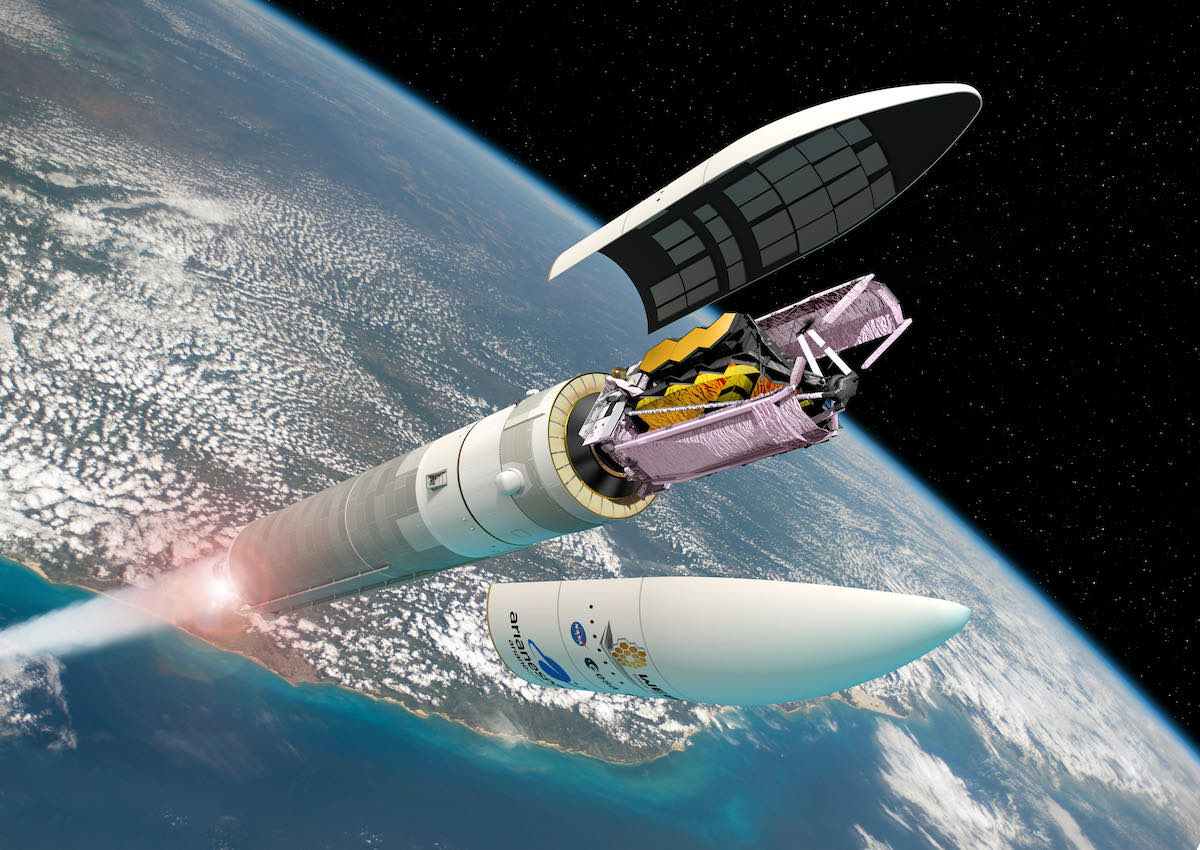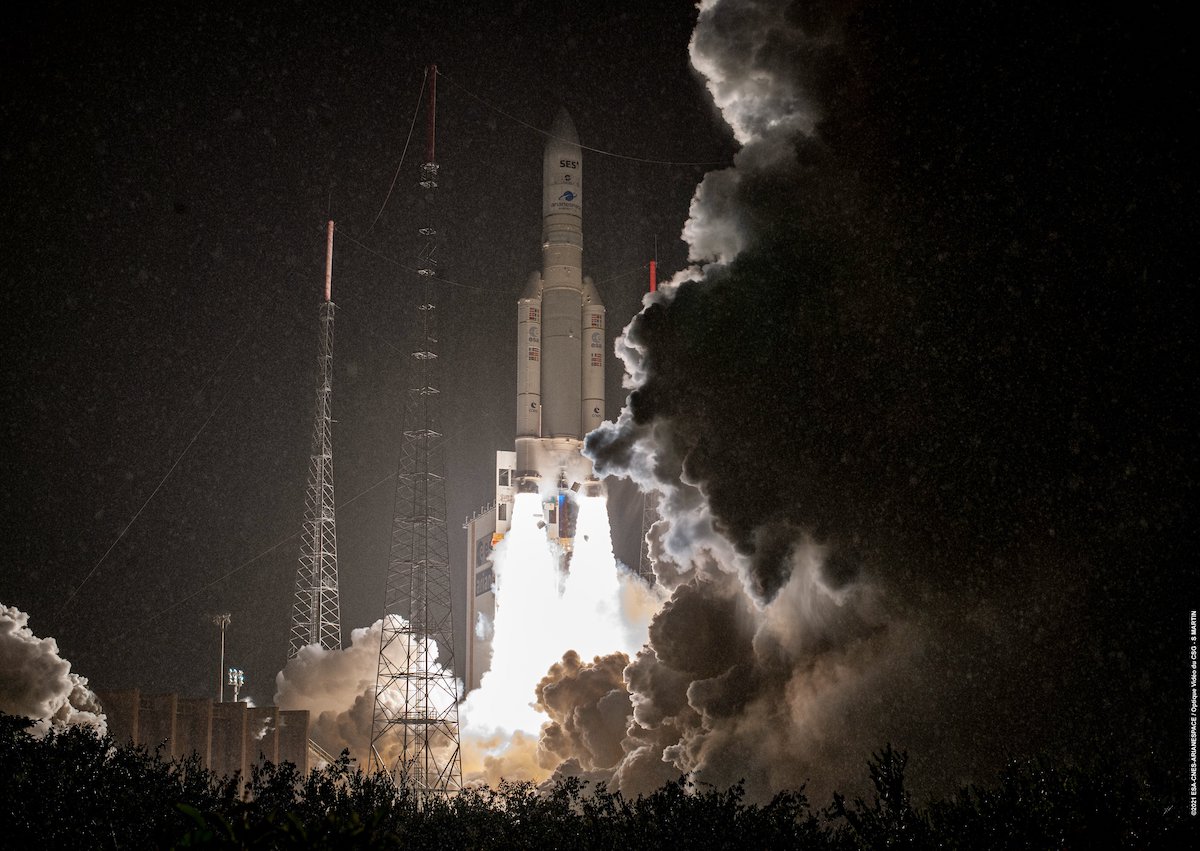Space News & Blog Articles
Ariane 5 fairing cleared for Webb launch after “perfect” performance on last flight
 Artist’s illustration of the payload fairing jettisoning from an Ariane 5 rocket, revealing the James Webb Space Telescope. Credit: ESA/D. Ducros
Artist’s illustration of the payload fairing jettisoning from an Ariane 5 rocket, revealing the James Webb Space Telescope. Credit: ESA/D. Ducros
The payload fairing on the most recent Ariane 5 launch last month worked perfectly, according to the European Space Agency, helping clear concerns about the shroud before liftoff of the James Webb Space Telescope on the next Ariane 5 flight in December.
The nose cone structure, built by the Swiss company RUAG Space, is designed to protect sensitive satellites during their time on the launch pad before liftoff, and during the first few minutes of ascent through the atmosphere. Once in space, the rocket jettisons the no-longer-needed fairing in two pieces, like the halves of a clamshell.
On two Ariane 5 missions last year, the payload fairing separated from the launcher in a “less than fully nominal” manner, causing vibrations on the rocket’s satellite passengers above safety limits. The satellites were not damaged by the payload fairing separation anomalies, and the Ariane 5 successfully placed the payloads into their intended orbits.
But Arianespace, the Ariane 5’s commercial launch operator, paused launches to investigate the fairing problem. Arianespace introduced a change to the fairing for the two most recent Ariane 5 flights on July 30 and Oct. 23.
Those missions validated the change to the fairing, according to Daniel De Chambure, acting head of the Ariane 5 adaptation program for the European Space Agency.
“The last flight was absolutely perfect with respect to the fairing separation, both in terms of dynamics of the launcher and also in the kinematical separation effects,” de Chambure said Friday during a media tour of the Ariane 5 launch base in Kourou, French Guiana. “For everybody — Arianespace, NASA, and ESA — there is no issue any more with respect to this anomaly we faced last year.”
Peter Jensen, ESA’s former project manager for Webb and now a consultant on the program, said the payload fairings flown in July and October were fully instrumented. “So we have a full picture of what happened to the fairing.”
NASA, ESA, and Arianespace managers discussed the Ariane 5 fairing data and other mission details during a flight readiness review Oct. 28. The readiness review cleared the way for the start of the Ariane 5 launch campaign at the Guiana Space Center, a European-run spaceport on the northern coast of South America.
Teams at the spaceport raised the Ariane 5 rocket’s core stage onto a mobile launch platform Saturday inside the launcher integration building. Two powerful solid rocket boosters, already packed with their powder propellant, are set to be installed on each side of the core stage in the next few days.
Once the rocket’s upper stage and avionics bay are stacked, Arianespace will transfer the Ariane 5 to a nearby final assembly building, where the 35-foot-tall (10.66-meter) Webb observatory will be hoisted on top of the launcher. The final piece to be added will the payload fairing to surround Webb.
The Ariane 5 will roll to the launch pad Dec. 16 in preparation for liftoff at 7:20 a.m. EST (1220 GMT; 9:20 a.m. French Guiana time) on Dec. 18.
 An Ariane 5 rocket lifts off from the Guiana Space Center on Oct. 23 with the SES 17 and Syracuse 4A communications satellites. Credit: ESA/CNES/Arianespace/S. Martin
An Ariane 5 rocket lifts off from the Guiana Space Center on Oct. 23 with the SES 17 and Syracuse 4A communications satellites. Credit: ESA/CNES/Arianespace/S. Martin
The James Webb Space Telescope folds up origami-style to fit under the Ariane 5 rocket’s payload shroud, then unfurl solar panels, antennas, a segmented mirror array, and a thermal sunshield the size of a tennis court after separating from the Ariane 5 on the way to an observing post nearly a million miles (1.5 million kilometers) from Earth.
Once in position, JWST’s telescope — the largest ever flown in space — and four science instruments will peer into the distant universe, studying the turbulent aftermath of the Big Bang, the formation of galaxies and the environments of planets around other stars.
ESA, Arianespace and RUAG also changed the design of vents on the Ariane 5’s payload shroud to address a concern that a depressurization event could damage the Webb observatory when the fairing jettisons after liftoff. Engineers were concerned residual air trapped in Webb’s folded sunshield membranes could cause them to suddenly bubble or expand at the time of fairing separation.
The vent modification will help sure there is no air caught between the sunshield membranes as the rocket climbs above the atmosphere.
The Ariane 5 is one of the most reliable launch vehicles in the world, with just one partial failure in its last 97 missions. The European Space Agency is paying for Webb’s launch as part of its contribution to the mission. NASA paid the bulk of Webb’s development costs, and the Canadian Space Agency is the third partner on the mission.
The mission is costing NASA about $9.7 billion, including development costs and post-launch operations budgets. The contributions of ESA and the Canadian Space Agency drive the mission’s total cost above $10 billion, making Webb the most expensive space science mission in history.
This email address is being protected from spambots. You need JavaScript enabled to view it. the author.
Follow Stephen Clark on Twitter: @StephenClark1.
When you subscribe to the SpaceZE News Feed, we will send you an e-mail when there are new updates on the site so you wouldn't miss them.

